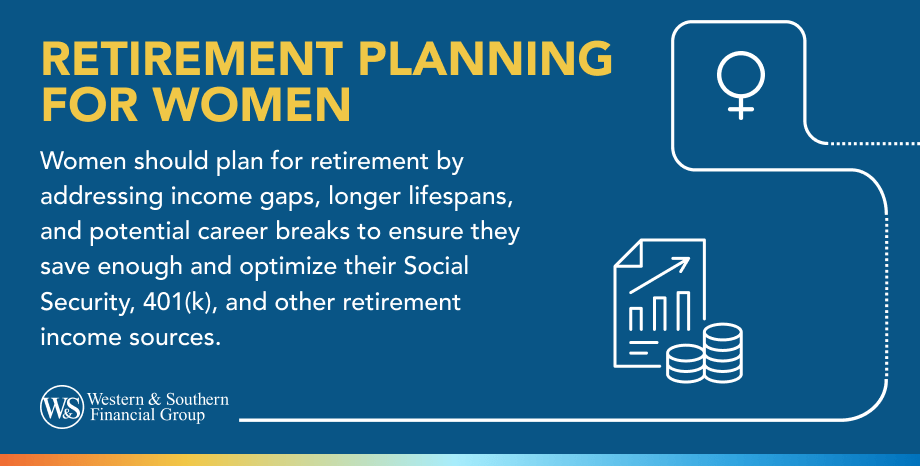

Table of Contents
Key Takeaways
- Women live longer than men, requiring more retirement savings.
- Women often earn less than men, leading to lower retirement savings.
- Caregiving roles often reduce women's earnings and savings potential.
- Women should set savings goals based on age, income, and retirement length.
- Women can use calculators and financial advisors to explore savings options like Social Security, 401(k)s, IRAs, and annuities.
With a longer life expectancy than men, women may have a little more time to enjoy their retirement. However, this could mean there's a greater chance they could outlive their retirement savings. This is just one reason why retirement planning for women can be a bit different from retirement planning for men.
Whether you're just getting started with saving for retirement or you're a few years away from saying goodbye to your full-time job, here are some things to consider when it comes to preparing for retirement.
Why Can Preparing for Retirement Be Different for Women?
Retirement planning for women may differ from planning for men because women live longer than men on average. The average American woman who turns 65 today can expect to live until she's 86.9, according to data from the Social Security Administration (SSA).1 Men in the same age range can expect to live, on average, until they're 84.3. This 2.6-year gap means the average woman may spend more time in retirement, and so she might need more savings to help avoid running out of money.
Women also tend to earn less than men over the course of their careers. According to U.S. Census Bureau data, women earned 84 cents for every dollar a man made.2 In the context of a 30- to 40-year career, that could potentially be hundreds of thousands of dollars in earnings that could have been invested to help increase a woman's retirement savings.
On top of this, women are more likely to take extended time off from the workforce to have children and to stay at home with them or to care for an aging parent. All of this work is invaluable — but it's unpaid. Women are more likely to be impacted by each of these factors.
How Can Women Prepare for Retirement?
One place to start is to know your retirement priorities. For example, do you plan to downsize your home and travel, or move to an area with a lower cost of living after you retire? Your savings target will likely factor in your expected retirement age, current retirement savings, current income and the anticipated length of your retirement, among other considerations.
Leveraging resources such as a retirement calculator or conversations with a financial representative might help you determine your savings goal based on your current and future needs.
What Are Some Retirement Savings & Income Considerations?
Social Security
Depending on how much you earn over your career and when you plan to begin withdrawing Social Security, you might receive monthly benefits that can help with some of your retirement costs. The SSA allows you to review your earnings history online. Creating a my Social Security account can help you track your estimated monthly benefit so you can keep this in mind as you prepare for retirement.3
401(k)s & IRAs
You'll also want to consider how you'll save for retirement. Many people have a 401(k) through their employers, while others have an individual retirement account (IRA) or both. These tools can help you build your retirement savings according to your personal financial goals.
Annuities
You might also consider purchasing an annuity to provide guaranteed income in retirement. With an annuity, you can contribute money that earns interest tax-deferred. In return, you can get regular payments as income — or you can withdraw those funds when you need them at a later date. Any withdrawals you make before the age of 59 1/2, however, will be subject to a 10% penalty fee.
From longer life expectancy to gender pay disparities, the average woman has a lot to consider when preparing for retirement. Still, no retirement approach is a one-size-fits-all solution. Whether you're starting early or you're a few years away from retirement, reviewing your retirement goals — either on your own or with a financial representative — can help you plan ahead for your needs.
Sources
- Retirement & Survivors Benefits: Life Expectancy Calculator. https://www.ssa.gov/OACT/population/longevity.html.
- National Equal Pay Day, 2024. https://www.federalregister.gov/documents/2024/03/14/2024-05587/national-equal-pay-day-2024.
- Create your personal my Social Security account today. https://www.ssa.gov/myaccount/.
















